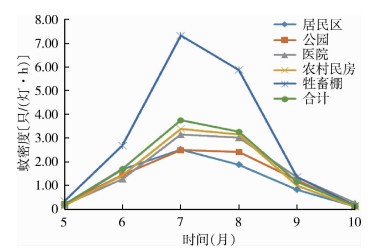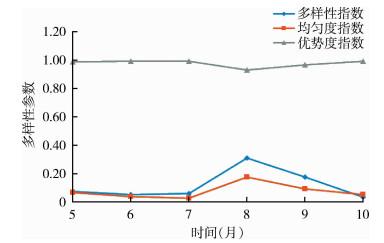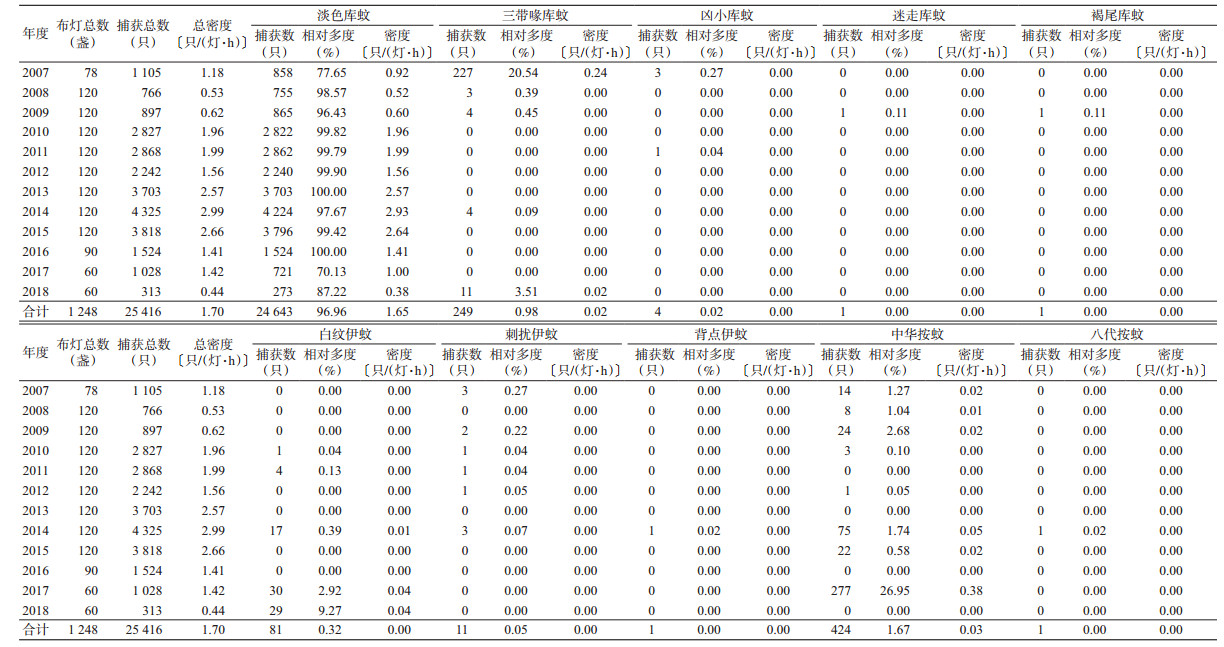Seasonal variation of mosquito density and species diversity in Tangshan, Hebei province, China, 2007-2018
唐山市位于渤海湾中心地带, 东依滦河, 南临渤海, 属于暖温带半湿润季风型气候, 夏季受海洋暖湿气团影响, 高温、高湿、降雨量大且降雨次数多, 地理环境和气候条件较适宜蚊虫的孳生和繁殖。蚊虫是多种虫媒传染病重要媒介, 为了解唐山市蚊类的组成及群落特征、物种多样性及季节消长等情况, 本研究收集和应用2007-2018年各年5-10月唐山市市区蚊种的监测数据, 对不同年月、不同生境的蚊种密度、多度、物种多样性及消长情况进行了测定、比较和分析, 为当地蚊媒疾病的防控提供参考依据。
1 材料与方法
1.1 监测方法 按照《全国病媒生物监测方案(试行)》[1]的蚊虫监测方案, 选用诱蚊灯法, 在唐山市区选取居民区、公园、医院, 在郊区选取民房和牲畜棚5种监测生境, 每个监测点布放1盏诱蚊灯, 日落后20 min开始监测, 连续监测6 h, 每年5-10月进行, 每月监测2次。
1.2 鉴定方法 蚊虫鉴定种类的方法按照《中国重要医学昆虫分类与鉴定》[2]。
1.3 统计分析 使用Excel 2007和SPSS 22.0软件进行数据处理, 对蚊种的构成采用χ2检验, P < 0.05为差异有统计学意义。根据物种多样性指数(H')、均匀度指数(J)、优势度指数(D)和种群相对多度(Ra)研究蚊虫多样性特征, 计算公式如下[3-5]:
 , 式中Ni表示第i种的个体数,
N为总个体数, S为物种总数。
, 式中Ni表示第i种的个体数,
N为总个体数, S为物种总数。
J=H'/lnS, 式中H'表示多样性指数, S为物种总数。
D=nmax/N, 式中nmax为群落中最大物种的个体数, N为总个体数。
Ra=Ni/N×100%, 式中Ni表示第i种的个体数, N为总个体数。
2 结果
2.1 不同年份蚊种密度及相对多度 共捕获蚊虫3亚科3属10种25 416只, 蚊虫总密度为1.70只/(灯·h)。其中库蚊属有5种, 分别为淡色库蚊(Culex pipiens pallens), 相对多度为96.96%, 为优势种, 密度为1.65只/(灯·h); 三带喙库蚊(Cx. tritaeniorhynchus)、凶小库蚊(Cx. modestus)、迷走库蚊(Cx. vagans)和褐尾库蚊(Cx. fuscanus)的密度和相对多度见表 1。伊蚊属有3种, 分别为白纹伊蚊(Aedes albopictus)、刺扰伊蚊(Ae. vexans)和背点伊蚊(Ae. dorsalis), 按蚊属有2种, 分别为中华按蚊(Anopheles sinensis)和八代按蚊(An. yatsushiroensis), 其相对多度和密度见表 1。不同年份成蚊种群构成不同(χ2=3 393.930, P < 0.001)。
表 1 河北省唐山市2007-2018年蚊密度及其相对多度
Table 1 Density and relative species abundance of mosquitoes in Tangshan city, Hebei province, 2007-2018
2.2 不同生境蚊种密度及相对多度 不同生境蚊密度从高到低的顺序为牲畜棚、农村民房、医院、公园和居民区, 密度分别为2.94、1.53、1.52、1.31和1.19只/(灯·h), 5种生境中均以淡色库蚊为主, 不同生境不同蚊种密度及其相对多度见表 2。
表 2 河北省唐山市2007-2018年不同生境蚊种密度及其相对多度
Table 2 Density and relative species abundance of mosquitoes in different habitats in Tangshan city, Hebei province, 2007-2018
2.3 不同生境蚊类的物种多样性 唐山市2007-2018年居民区中的蚊种丰富度为5种, 公园、医院和农村民房中蚊种的丰富度均为6种, 牲畜棚中为7种, 牲畜棚的物种丰富度最高。物种多样性指数最高的为居民区, 为0.23, 其次是公园、医院和牲畜棚, 分别为0.22、0.17和0.14, 农村民房最低, 为0.10。在均匀度指数中, 居民区最高, 为0.14, 农村民房最低, 为0.06。在优势度指数中, 农村民房最高, 为0.98;居民区最低, 为0.95。各年份不同生境的蚊种群落生态学参数见表 3。
表 3 河北省唐山市2007-2018年不同生境蚊虫群落生态学参数
Table 3 Community ecological parameters of mosquitoes in different habitats in Tangshan city, Hebei province, 2007-2018
2.4 蚊虫密度和物种多样性的消长情况 总蚊密度高峰出现在7月, 密度为3.75只/(灯·h), 呈单峰型。从不同生境看, 5种生境季节消长均呈单峰曲线, 高峰均出现在7月, 其消长曲线与总密度高峰曲线类似, 见图 1。
不同月份蚊虫的多样性指数和均匀度指数最高均出现在8月, 分别为0.31和0.17;优势度指数最高出现在10月, 为0.99, 见图 2。
3 讨论 蚊虫监测及其群落特征分析是研究某一地区蚊虫多样性的基本方法, 也是蚊媒疾病的监测内容之一[6]。
唐山市2007-2018年5-10月的成蚊监测显示, 共发现蚊类10种, 其中主要蚊种有淡色库蚊、中华按蚊、三带喙库蚊和白纹伊蚊, 蚊种组成与河北省[7]、天津市[8]调查的结果基本相同。优势蚊种为淡色库蚊, 其次是中华按蚊。密度较低的蚊种有凶小库蚊、迷走库蚊、褐尾库蚊、刺扰伊蚊、背点伊蚊和八代按蚊。淡色库蚊和中华按蚊可以传播丝虫病和疟疾, 其自身也可以携带多种病毒[9-10], 应引起当地疾控部门的重视。
从不同生境看, 唐山市蚊密度最高的生境是牲畜棚, 最低的生境是居民区, 这一结果可能与牲畜棚环境卫生脏乱差, 多有污水淤积, 为蚊虫提供了吸血场所有关[11]。居民区蚊密度最低与当地政府加大了对居民区的卫生清理, 及时清除积水, 并定期为居民区喷洒灭蚊药物有关。
对唐山市2007-2018年监测的蚊种进行群落生物学参数分析, 蚊种的丰富度居民区为5种, 公园、医院和农村民房中均为6种, 牲畜棚中为7种。分析了蚊种多样性指数、均匀度指数和优势度指数, 多样性指数和均匀度指数均是在居民区最高, 在农村民房最低, 这是由于群落中物种的丰富度以及各物种数量的均匀度共同界定了物种的多样性, 优势度则是反映了物种多样性的另一个参数。多样性指数和均匀度指数的趋势相同, 多样性越高, 则物种的均匀度越高, 优势度的定义和结果则与二者相反, 优势度数值高说明种群中优势物种的数量比较突出, 相反均匀度就会较低, 多样性也会较低[12]。所以本研究优势度指数在农村民房最高, 在居民区最低。
唐山市2007-2018年每年的总蚊密度高峰均出现在7月, 5种生境蚊密度高峰也都出现在7月, 主要是由于7月唐山市的气候炎热多雨, 蚊虫的繁殖、数量及分布与气温和湿度有一定的关系[7, 13]。因此, 也导致和形成了当地蚊类密度单峰分布的格局及特征。群落生态学参数进行季节消长分析显示, 2007-2018年多样性指数最高出现在8月, 说明8月蚊虫种类相对最多, 随着气温的升高, 降雨的增加, 蚊虫孳生迅速, 在7月蚊密度达到最高峰之后, 随之8月蚊种也出现了高峰。均匀度指数也是在8月达到高峰, 说明在8月蚊种最多的同时, 各种蚊种的数量也相对比较均匀。优势度指数的高峰出现在10月, 随着气温的迅速下降, 蚊虫种类和数量都是迅速的减少, 而淡色库蚊的数量就形成了绝对优势。
物种多样性研究是研究有害生物过程中的一种常用方法, 通过分析有害生物种群的多样性, 来研究病媒生物与其他生物之间以及与地理环境分布、气候因素的改变之间的关系, 本文从生态系统的角度深入研究了该物种的群落构成、种群动态和生物演替的全过程, 对有效防制病媒生物具有深远的意义[14-15]。
 2020, Vol. 31
2020, Vol. 31










